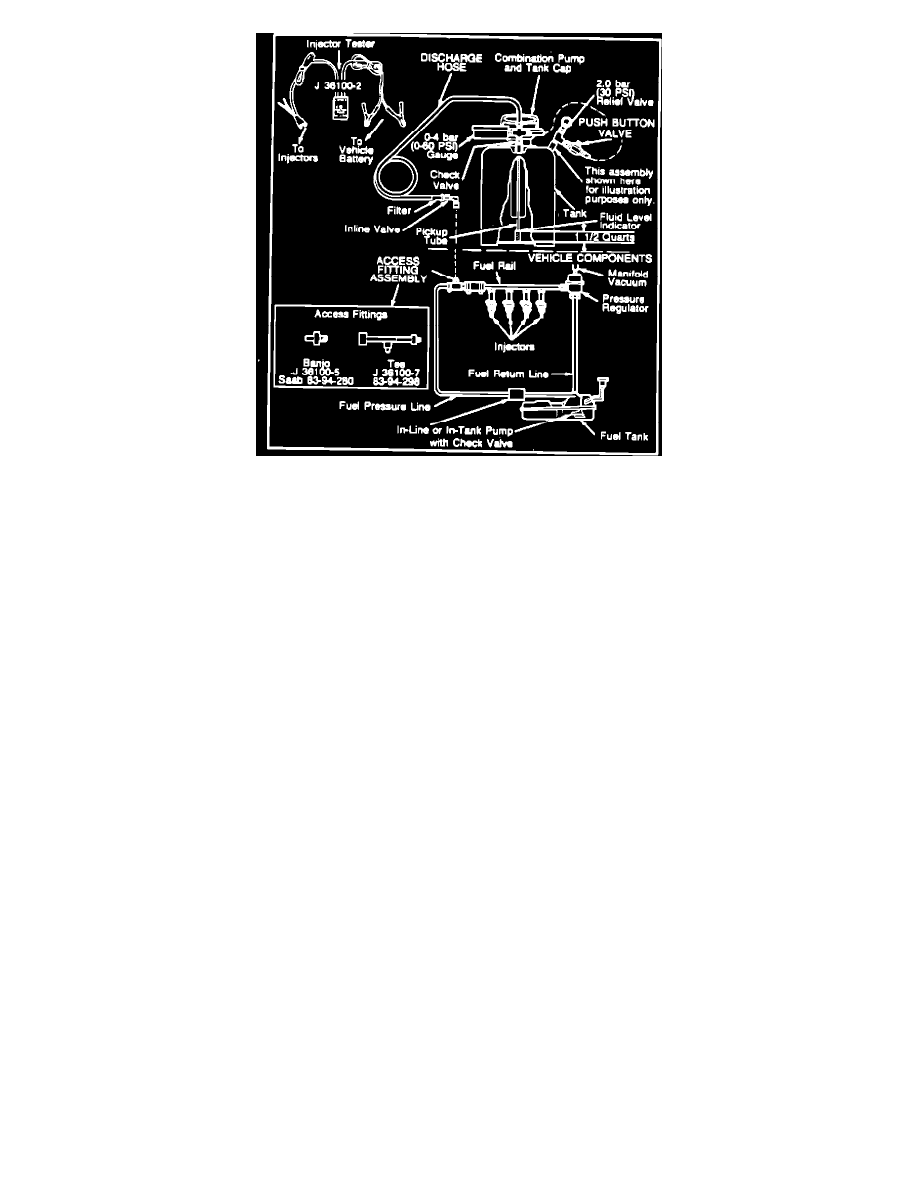9000 L4-1985cc 2.0L DOHC (1986)

5B. Energize vehicle electric fuel pumps using switch on jumper lead 83-93-886. Refer to service manual for proper connection.
6B. Hold push button valve open, draining 1-1/2 quarts of fuel into cleaner tank.
NOTE:
Top of fuel level indicator tube inside cleaner tank is 1-1/2 quarts (see drawing last page).
7B. Turn off electric fuel pumps.
8B.
Add 3 ounces ONLY of Kent-Moore fuel injector cleaner to cleaner tank. Use
only Saab approved injector cleaning solvent. NOTICE: Do not exceed 3 ounces of injector cleaner in 1-1/2 quarts of gasoline and do not add
cleaner directly to fuel tank, as severe damage to the fuel system components may result.
9B.
Bleed discharge hose by opening push button valve. Install pump and cap
assembly into cleaner tank turning clockwise. Pump until pressure gauge indicates 2 bar (30 P.S.I.) or pressure relief valve opens.
10B. Disable vehicle electric fuel pumps by removing fuse. NOTE: BLOCK THE RETURN LINE USING A HOSE PINCH-OFF OR SIMILAR SOFT
JAW PLIERS AS A SAFETY MEASURE. THIS CONFINES THE CLEANER SOLUTION TO THE INJECTOR RACK AND DOESN'T ALLOW
THE CLEANER TO ENTER THE FUEL TANK.
11B. Start engine and run at approximately 3000 RPM, for 15 to 30 minutes, depending upon engine fuel consumption. After 15 to 30 minutes of
running, if engine runs out of cleaning solution or starts to stumble steadily, decrease the RPM to idle and shut ignition off. During this time if you notice
a pressure drop on the cleaner gauge of 0.2 bar (3.0 PSI) or more, bring pressure back up by using the hand pump.
12B. Close access fitting valve and bleed discharge hose by opening push button valve.
13B. Remove return line pinch-off pliers. Energize vehicle electric fuel pumps.
14B. Immediately run engine for 5 minutes at 2000 RPM to flush cleaner from fuel rail and injectors.
15B. To re-test injectors repeat test steps 5A thru 14A to determine if injectors are within specification. If injectors are still not within 0.2 bar (3.0 PSI)
repeat cleaning steps 4B thru 14B.
If after the second cleaning injectors are still not within 0.2 bar (3.0 PSI) as indicated in step 14A, then an injector(s) may be defective. Replace as
necessary.
16B. Depressurize discharge hose and fuel rail (with inline valve still open) by pressing the push button valve until gauge shows no pressure. Relieve the
pressure from the cleaner tank through the relief valve pull ring.
17B. Close inline valve on discharge hose and remove access fitting assembly immediately. NOTE: Whenever disconnecting a hose from the inlet pipe
of the fuel rail, wear eye protection and wrap a shop rag around the inlet of the fuel rail to prevent and absorb gasoline spray. Remember fuel is under
pressure.
18B. Check fuel line seals, replace as necessary. Re-connect car fuel line to original location.
